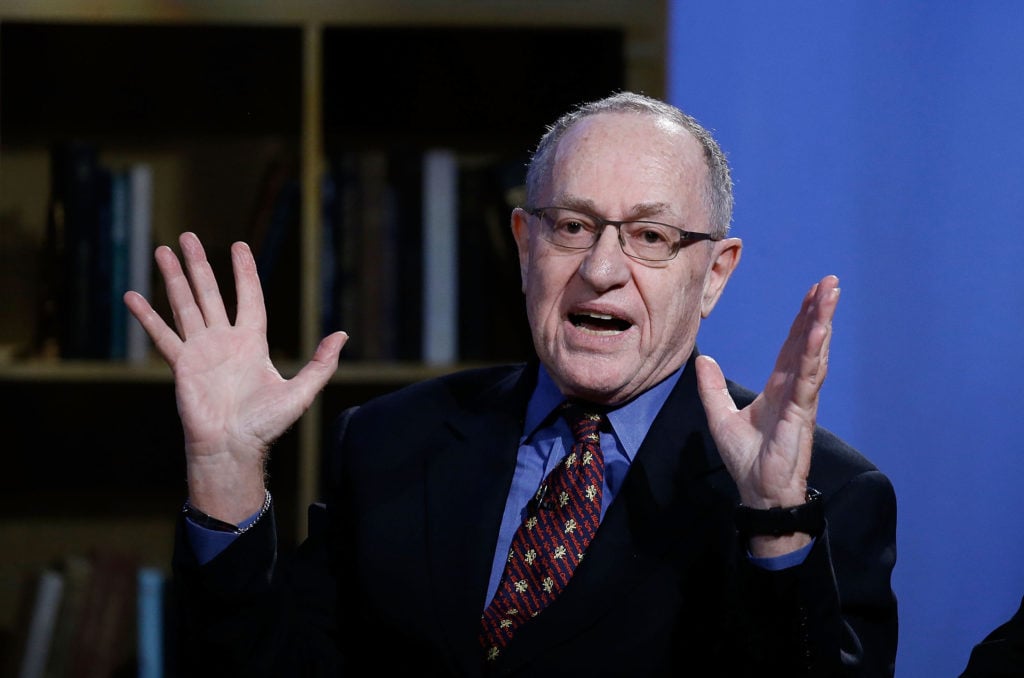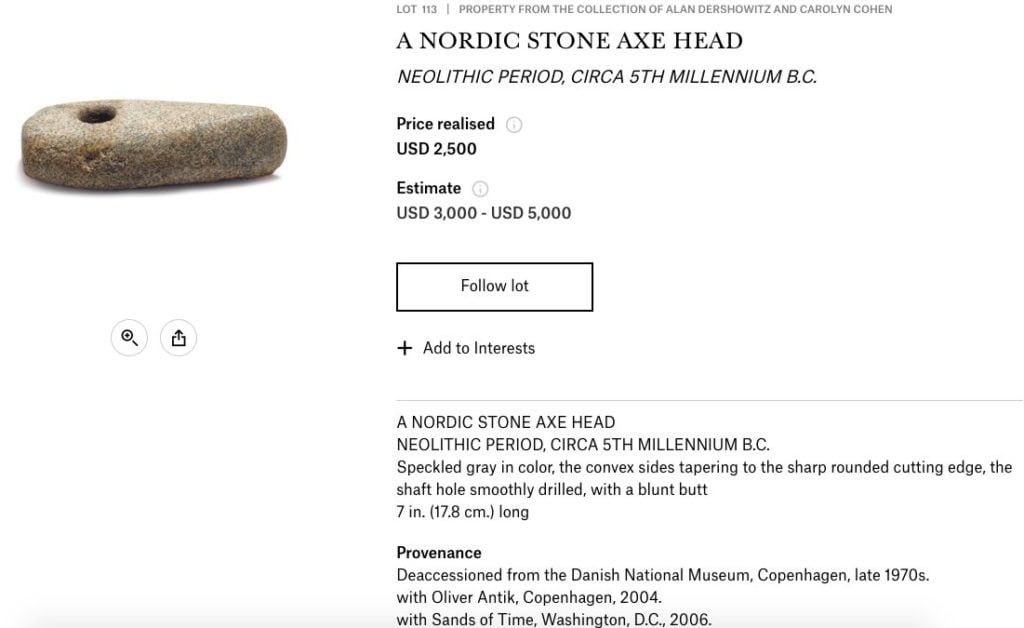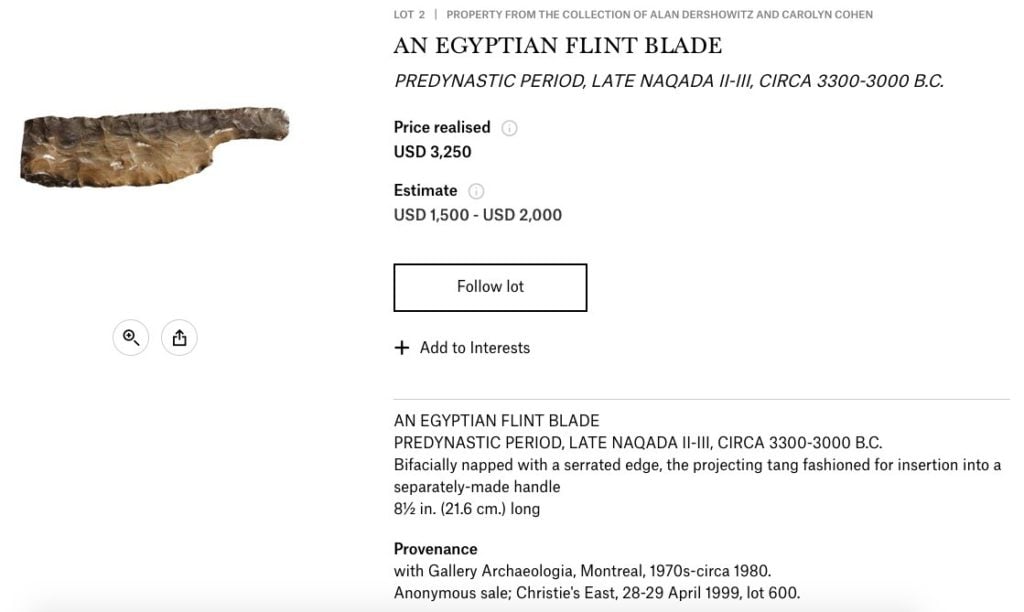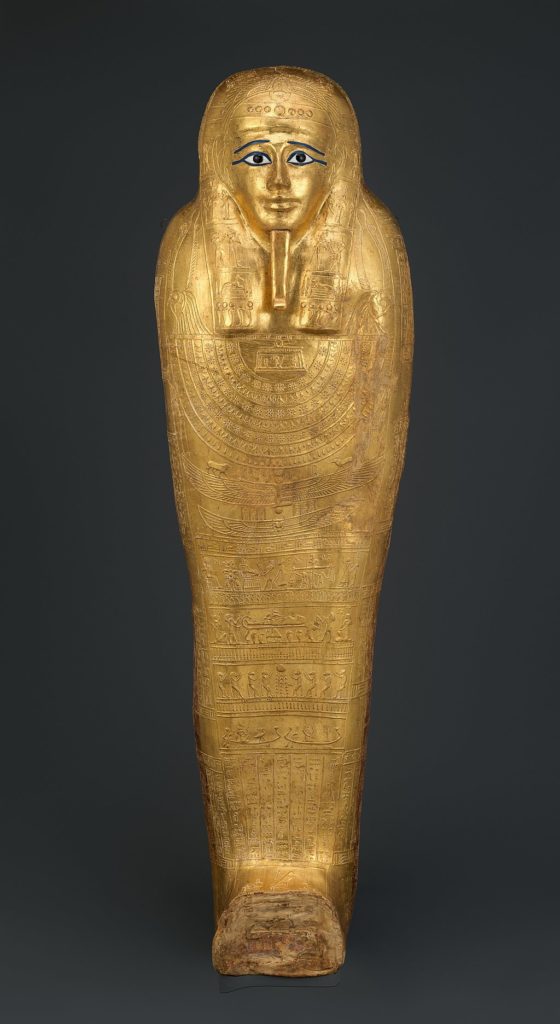https://news.artnet.com/art-world/dershowitz-antiquities-art-crime-expert-1772157
Trump's Impeachment Lawyer Alan Dershowitz May Have Owned Looted Antiquities, an Art Crime Expert Says
Experts say Dershowitz is emblematic of collectors in this fraught market, where a lack of documentation is common and troubling.

Standing before the United States Senate last week, the lawyer Alan Dershowitz argued that his client, President Donald Trump, should be acquitted of all impeachment charges, because the commander-in-chief's conduct with Ukraine did not rise to the level of criminal activity.
On Wednesday, the Senate voted to acquit Trump of all charges. But impeachment has also reignited harsh questions about Dershowitz himself, particularly with respect to his art collecting. Some experts are now revisiting claims that looted antiquities may potentially have passed through Dershowitz's eclectic art collection, which also includes Judaica, prints, and Impressionist art.
If so, it's a story that historians and archaeologists say is all too common in the art market, where illicit artifacts can recirculate through the major auction houses, which have a motivation to obscure the potential weakness of provenance in pursuit of profits.
Last week, Erin Thompson, an art crime professor at John Jay College, raised questions on Twitter about Dershowitz's antiquities, alleging that of 27 antiquities that he sold for a total of $155,250 at a 2012 Christie's auction, only two of them are listed with any indication of a pre-1970 provenance. In an interview with Artnet News, Dershowitz said that it was "categorically false" that he owned anything illicit, adding that he sold virtually his entire collection of ancient works in 2012 through Christie's, where the company's head of antiquities certified his ancient objects as genuine.

Screenshot of Christie's sale of Property from the Collection of Alan Dershowitz and Carolyn Cohen.
"I would never, ever purchase or own anything that was in any way suspicious," the lawyer said. "Everything I bought was through Christie's and Sotheby's, and everything I sold was through the auction houses, as well." He added that he relied on the auction houses for provenance.
A Fraught Market
Thompson notes that the major auction houses have improved their practices in recent years, even withdrawing from sale and facilitating the return of some artifacts when issues arise (though not always without putting up a fight). Still, the market for antiquities remains fraught, especially when it comes to low-value artifacts that rarely receive the same provenance and forensic research as high-value works.
"Auction houses want to assure clients that they are buying genuine antiquities," Thompson told Artnet News. "They have an interest in assuring buyers … that everything is kosher." But in her opinion, relying on an auction house is a bit like "buying a used car, and when it breaks down, saying that the salesman told you it was in great condition."
Responding to a request for comment, a Christie's spokesperson said the auction house would not sell any work it believes has been stolen. Its cultural stewardship policy says that Christie's devotes "considerable resources to investigating the provenance of objects we offer for sale" and has a program "of specific procedures, including the requirement that our sellers provide verifiable evidence in order to ensure that the works in our sales have not come from conflict zones." (Sotheby's did not immediately respond to a request for comment.)
The push for stricter guidelines surrounding the trade of antiquities began in 1970, when UNESCO developed international protocols that lay out preventive measures and restitution provisions for member states. Under the terms of the convention, source countries that believe there has been a theft of an antiquity must initiate restitution requests and furnish evidence that the objects were looted.
Following the UNESCO convention, dealers and collectors began becoming more careful with their provenance documentation. But because the black market for antiquities proliferated in the decades leading up to the 1980s, most provenance experts, as well as American museums, now insist on having documentation of ownership that can be traced prior to 1970. (Although such lack of pre-1970 documentation is common and does not necessarily mean an artifact is fake or stolen, it can be a sign that an artifact was looted or the subject of illegal export.)

Screenshot of Christie's sale of Property from the Collection of Alan Dershowitz and Carolyn Cohen.
"I don't think Dershowitz has purchased anything especially suspicious," said Thompson, "but he has participated in a marketplace that many—including myself—believe to have serious ethical issues." When the professor examined the Dershowitz collection on the Christie's website, most of the antiquities listed had no indication of a pre-1970 provenance, including an ancient Egyptian painted wood coffin fragment that could only be traced to the European art market in the 1980s.
The same year Dershowitz auctioned off his collection of ancient artifacts, he appeared in a New York Times article that discussed how stricter museum standards made it difficult for collectors like the celebrity lawyer to donate or sell their ancient wares. He had trouble selling an Egyptian sarcophagus he bought from Sotheby's in the early 1990s because of the tighter rules that auction houses placed on accepting consignments.
"I can't get proof of when it came out of Egypt," Dershowitz said at the time, though he recently confirmed with Artnet News that he no longer owns either of the two sarcophagi mentioned in the article, and that they were sold at auction.
Warning Signs
In cases where documentation is spotty, some in the trade also use forensic testing to help support an artwork's authenticity and history. According to Thompson, the 12 terracotta oil lamps that Dershowitz sold could have been tested for thermoluminescence, a method of dating ancient ceramics and pottery by the last time an object experienced the extreme heat of something like a kiln. Such processes, however, are costly, disincentivizing auction houses from performing such an analysis on cheaper lots. (Thompson said that the lamps, which sold for $8,750 at Christie's, would have been unlikely to receive thermoluminescence testing; Christie's did not comment. The combined sum from the Dershowitz sale was $155,250.)
But beyond expensive tests, there are other indicators within established provenance records that experts say could indicate a problematic past. In 2017, the British archaeologist Paul Barford noticed something peculiar about a Bonhams sale of bronze "erotic" sculptures, which included at least one item from Dershowitz's 2012 Christie's sale: a second-to-first century B.C.E. artwork depicting a man and woman having sex in an upright position.
Provenance for the sculpture only went as far back as an anonymous sale in 1999 and was described as coming from "Southern Arabia," which Barford described as a common euphemism in the art trade for Yemen. In a blog post, Barford opined that the Bonhams catalog reference to the Christie's 2012 sale was insufficient "to assert an easily smuggled object like this came on the market licitly," especially when Yemen's 1994 civil war emptied the country's museums. (Bonhams did not immediately reply to a request for comment.)

The gilded coffin of Nedjemankh, which was returned to Egypt last year. Photo courtesy the Metropolitan Museum of Art.
For Tess Davis, the executive director of the Antiquities Coalition, a nonprofit lobbying against the trafficking of ancient objects, the revived scrutiny on Dershowitz's collecting history may serve as a wake-up call to others in the sector to remain vigilant. Even the Metropolitan Museum of Art recently relinquished antiquities based on evidence that they had been stolen. "If major institutions, with their unparalleled expertise and resources," Davis said, "can't guarantee that their purchases are legal, ethical, and authentic, how can an individual collector like Dershowitz?"
A Wake-Up Call?
Making matters more difficult, experts say, is the fact that most antiquities collectors lack the training to conduct provenance research themselves, and there are few independent third parties that can provide such a service. "When it comes to due diligence, there really is no standard," said Leila Amineddoleh, a lawyer specializing in art crime and cultural heritage who worked with the Manhattan District Attorney on the repatriation of an Egyptian coffin from the Met last year. "But the problem with looted objects is that if you keep selling them, it shows that there is a market for objects without good provenance."
Experts like Amineddoleh, Davis, and Thompson agree that the market can sometimes facilitate the recirculation of illicit artifacts without the full knowledge of buyers. And for owners of forged antiquities, there can be an immense financial loss when collectors eventually set out to sell their wares only to be rejected by an auction house during the vetting process.
But the ultimate price is paid by the people living in war-torn areas where looting and forgeries can proliferate. "These people are victims in so many ways," Amineddoleh said, "and then their heritage is being destroyed."
"Given his public prominence, Alan Dershowitz has an opportunity here," added Davis. "I hope he'll take it and make himself an ethical leader in the field."
-- Sent from my Linux system.
I am very glad to here. Please check my blog website. And revert back with few suggestions please.
ReplyDeleteTheFreeGuy